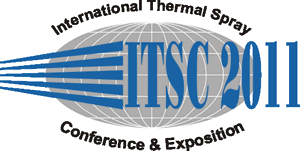
|
2752 |
|
Comparison of microstructures and deposition behavior of warm sprayed and cold sprayed metallic powder particles |
|
KeeHyun Kim / University of Birmingham, UK Seiji Kuroda*/ NIMS, Japan Makoto Watanabe/ NIMS, Japan RenZhong Huang/ Plasma Giken Co. Ltd., Japan Hirotaka Fukanuma/ Plasma Giken Co. Ltd., Japan Hiroshi Katanoda/ Kagoshima University, Japan |
|
Kinetic spraying processes such as cold spraying (CS) and warm spraying (WS) can make dense coatings on substrate to improve the required properties. In CS, a supersonic jet of compressed gas passed through DeLaval type nozzle, without using combustion, accelerates small size (1~50 um) particles to a high velocity (300~1200 m/s) and facilitate the deformation of particles upon impact. In contrast, WS make dense and tightly bonded coating of sprayed solid particles accelerated and simultaneously heated by the supersonic flow of combustion gas made from a mixture of kerosene and oxygen. Moreover, the gas flow was mixed with inert gas such as nitrogen in order to lower the temperature of gas flow and consequently in-flight particles. The WS process enables to heat the feedstock powder to higher temperatures as compared to the CS. In this study, the microstructures and deposition behavior of WS and CS titanium coatings and powder particles were compared. Micro-sized titanium powder particles were utilized to make coatings or splats on substrate. The coating layer or deposited particles were observed by high resolution SEM and TEM. Regardless of spraying processes, most of the sprayed particles are deposited in solid state. However, the interface of warm sprayed or cold sprayed titanium particle and substrate showed the different microstructure. The internal microstructures and interface of splat/substrate will be deeply discussed to know the bonding mechanism. |